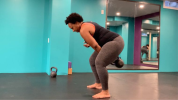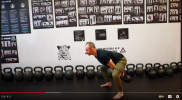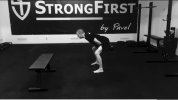I should have been more clear. See where I say, "as long as you're not squatting, actively lowering your hips..."? That's where I was trying to say that knee flexion (and therefore lowering your hips) is fine if you're not actually squatting - meaning, moving to lower your hips all the way down. Text-only is limited and Halfakneecap had already figured it out, so I cut my own schpiel too short. Normally when people ask me about their form on ballistics and about the whole hinge-squat thing, I'm either next to them or I go deeper into the details.
What I tell them is, this is not strength, it's power. Your goal isn't to go down or to go forward, it's to get into an poweful position. The bottom of a pure squat is a terrible place to generate power from, and so is the end of a pure hinge. Go down or bend forward to give your posterior chain more or less slack, to accommodate for your anatomy, to get into a more explosive position. I tell people to think, broadly, of a lineman in a three-point-stance, or a wrestler. They don't care if it's a hinge or a squat, they care about having their coils compressed under them so they can explode.
I will say I think it's better for beginners to emphasize the hinge. First, because if you tell a novice to purely hinge (most won't), they can still do KB ballistics. If they purely squat, they can't. Second, because de-trained individuals seem to be very unfamiliar with the hinge pattern. Everybody has an idea of what a squat is, but I find that, for a lot of people, a hinge is that creaky bit doors have.
It does generate a bit of a sanctimonious attitude, and people get stuck in their ways. Later, hopefully, as we all did, they learn form is not static - that it must change under heavier load, that it's actually revealed, discovered under heavier load. It might be counterintuitive, but I think we all kinda already know that teaching and learning in the long run is the process of internalizing rules of a game and then finding out later they were meant to be twisted - or broken.




